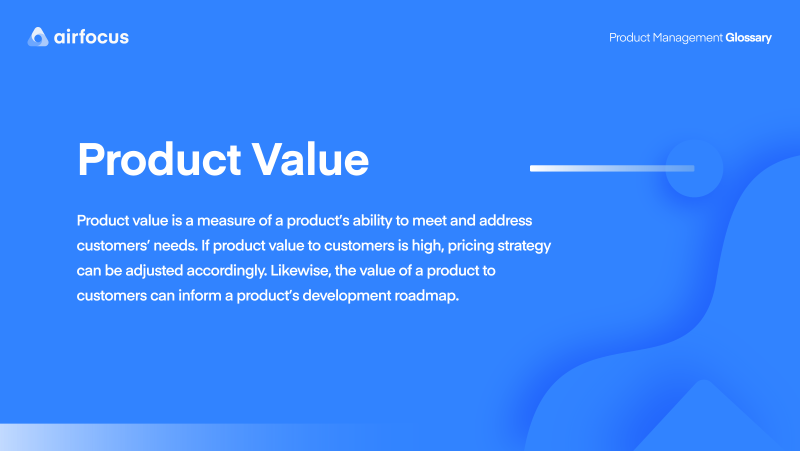Product Value
What is a product value?
Product Value Definition
Product value is a measure of a product’s ability to meet and address customers’ needs. If product value to customers is high, pricing strategy can be adjusted accordingly. Likewise, the value of a product to customers can inform a product’s development roadmap.
Product value is a useful tool for assessing the key benefits of a specific product. It is an extrinsic metric in the sense that it can only be derived through customers using and engaging with your product. Product value is not a fixed measure, in that it can change over time (i.e. perceived vs. real value) and is often impacted by external factors such as competitors and market conditions.
Examples of product value
Product value naturally varies from product to product, but it’s still best understood with real-world examples.
Here are some examples of product value that you may help define your own:
Availability: Customers can access the product online or offline.
Convenience: The product is available on multiple devices, including mobile.
Speed: The product does its job quickly with no lag or delay.
Cost: The product is more affordable than its competitors.
Types of product value
The four types of product value are:
Perceived value: How valuable a product appears to customers.
Practical value: A product’s tangible uses and benefits.
Identity value: How a product aligns with a customer’s identity and self-image.
Social value: How a product allows them to connect with others or appear in a specific way.
Why is product value important?
Measuring product value helps teams understand how effectively their creation solves the target customer’s problem, how to price it correctly, and whether further work is required to refine it.
How do you determine product value?
Determining product value is an interesting venture, mainly because the process begins externally.
During initial product development, a product management team will use their judgment and market research to assess customer need and product/market fit. But the real test is when it’s in customers’ hands.
To actually determine your product value, you’ll need to carry out some empirical research on how customers use your product. The primary tools for this will be product analytics (i.e. where are customers spending the most time), customer feedback sessions (i.e. asking why they like your product), or NPS surveys.
How to measure product value
Customer feedback should be gathered through interviews, surveys, and analytics. A business must understand customer pain points, current market offerings, and common issues when determining product value. Using the product value formula (product value = benefits/cost) can help teams calculate the product’s value too.
What is a product value statement?
Similar to an organization’s mission statement, a value statement is a summary of a product’s ability to solve the target customer’s core problems. When a prospective customer engages with any articulation of your product value statement — through web copy, social media, or other promotional messaging — they should recognize their hurdles and immediately see why (and how) your product could help tackle them.

General FAQ

Glossary categories
Experience the new way of doing product management

Experience the new way of doing product management








